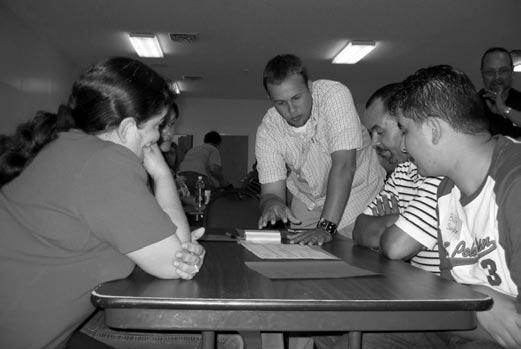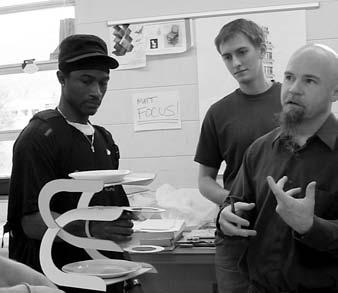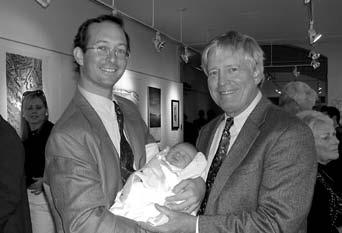
4 minute read
NC State to Improve Affordable Housing Options for the Lumbee Tribe
NC S t ate Team Helping Improve Af fordable Housing For L umbee Tribe
Father and son pair Michael Clark (B.Arch. 1971), and Ché Clark (M.Arch. 2004), and Architecture Professor Georgia Bizios are leading a team of NC State students who are working to improve housing for North Carolina’s Lumbee Tribe by designing affordable homes for Lumbee residents in southeastern North Carolina.
Advertisement
Michael Clark is NC State’s first Lumbee graduate in architecture. He is the owner of Native American Design Services, which was hired to assist the Tribe with creating home design guidelines. The Tribe had received a grant to support housing needs from the Federal Department of Housing and Urban Development (HUD). The HUD grant allows qualifying potential homeowners to receive guaranteed loans for the construction of new, quality-built houses. “I thought it would be a great marriage between the College of Design and the Tribe,” says Michael Clark. He realized that there was a great opportunity for collaboration between Tribe members and architecture students, who could bring a great deal of energy and design experience to the project. This kind of real world challenge inspires enthusiasm among design students. In projects like this, they must examine the unique cultural needs of a particular community and take responsibility for developing real solutions through design.
Michael Clark talked about this idea with his son Ché, who was completing his last semester toward earning a master’s degree in architecture, and with Georgia Bizios, whose architecture firm specializes in residential design. The Clarks and Bizios discussed the possibility of the College of Design’s involvement in the project, and then met with the Tribal Council. Together they developed a proposal which began to generate excitement for the collaboration. the recently built stock of affordable housing in the Robeson County region does not adequately meet the needs of the occupants in terms of durability, quality of construction and standards of design. As a means of addressing this issue, the Lumbee home design initiative will place an emphasis on the use of durable, high quality materials while incorporating recent trends in the production of affordable housing. As a result of the interaction with the ultimate homeowners, the team plans to engage elements of traditional Lumbee housing culture in the designs.
Bizios also saw an opportunity in a project that has dual benefits both for the community and for the students involved. In addition to providing a valuable service for the homeowners, this type of project is an excellent chance for students to learn by addressing issues of site and place for a unique client. In doing so they are able to work with broad concepts of home design while specifically enriching the project by their participation. She recruited graduate students who are working on the project at many different levels, from cultural
Photos from Lumbee community workshop held September 2004.
Designs to Accommodate Cultural Differences
Clark and many of his fellow Tribal members felt that much of

research to the home designs. In addition to Clark, the design team includes Marshall Dunlap, Katie Wakeford, K.C. Kurtz and Wendy Legerton. The project will continue over the coming years, and Bizios envisions a rotating membership as some students graduate and others are recruited to join the team.
The students have made a number of trips to Robeson County to get to know the environment. On September 21, 2004, they conducted a community workshop in Pembroke in order to get input from their eventual clients. The meeting was attended by over fifty members of the Lumbee Tribe, who represented all fourteen of the Lumbee districts in Robeson County.
The community meeting served as a brainstorming session, which brought up issues of housing that the community felt needed attention in the design of new affordable homes in the region. “The participants realized that their input is valuable,” Michael Clark said. “Even if each and every idea is not eventually included, the participants know their concerns were heard.”
Based on feedback from potential homeowners, the team is incorporating Native American themes and cultural elements – such as open spaces for meals and family gatherings – into their home designs. The ideas arising from the meeting focused on affordability, energy efficiency, sustainability, and traditional cultural gathering places.
The next step in the project will be a meeting with members of the Tribal Council to show them preliminary home designs based on the information gathered at the community meetings. The designs will be for 1500 square-foot prototypes with variations on each design. After getting feedback on the prototype designs, the team will begin to address issues of construction methods and neighborhood design.
Exposure to Architecture an Additional Benefit
Seeing the project as a mutually beneficial exercise between students and the Lumbee community and being a die-hard NC State fan, Michael Clark knew the Tribe would benefit from the pride that NC State takes in whatever it sets out to do for the community.
“Traditionally, homeowners in affordable housing communities do not get exposure to the profession and practice of architecture,” Michael Clark says. “This was a way to get young people in the region involved with the community at the meetings, and it educates them by exposing them to what an architect does.”
Michael Clark hopes that after being exposed to architecture, young people in the Tribe with talent will be able to go to Design Camp and learn more about the design disciplines and NC State. “This is a very fulfilling project,” Ché Clark says. “I see the extensive need for housing for my people, and I am proud to use my skills to help relieve some of that need. It means a great deal to be able to team up with my dad and provide much-needed architectural services to the Lumbee people.”











